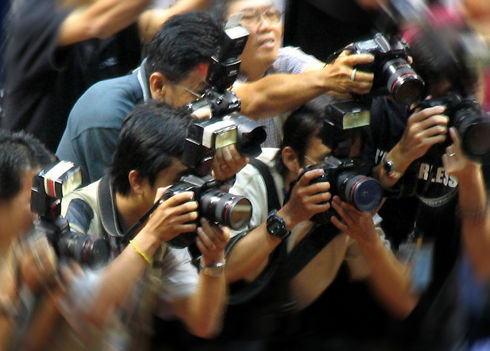On the positive side: With so many entry & midrange Nikon models surfaced during the F5 era, Nikon could easily increased a few folds in volume for AF-D lenses to the mass market. What I meant is, the Nikkor lens upgrading occurred during the entire generation of the F5 has MATURED in terms of mass market ownership. So, from now on, Nikon users should expect better things to come in the future - that is, of course, as long as Nikon understands millions of OLD & NEW owners will also form as a backbone for its continued growth in the future.
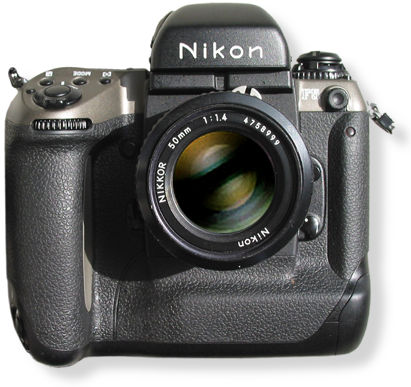 |
Lenses plays an important component in any 35mm SLR photographic system and it is also one of the most important element in deciding to choose a particular label to build a system. Nikon knows it and so do others. Few key areas in the Nikon system lead in technology and performance. From now on they need to take full advantage of them by introducing capable camera models to catapult the Company back to drivers seat - instead of letting many Nikon photographers take the second fiddlers role to others ...hehe. |
The picture above simply highlights some of the strange decisions Nikon made at times. I know many Nikon users are complaining by saying that the Nikkor lens line requires a total revamp or streamlining its entire product specification - which to me, is irrelevant to photography. Personally, to summarize impression of Nikon F5 era in a few paragraphs:
 |
It was the first model that has created watershed in how to operate a Nikon camera from now on via a combination of Main/Sub Command Dials and a 5-focus areas selector for autofocus control. |
It is a BIG and heavy camera but delivers the kind of performance and supreme level of reliability one would expect HOW a Nikon-F would behave. It revolutionizes SLR metering technology with its unique 3D color meter, incorporates an extremely fast & dead accurate autofocusing system. But other than the pros who will definitely appreciate what it has to offer, it was also probably the least appealing professional Nikon F-models for serious amateur photographers with its pricey, inseparable body / power pack unit & a less desirable lens compatibility issue Nikon created. |
|
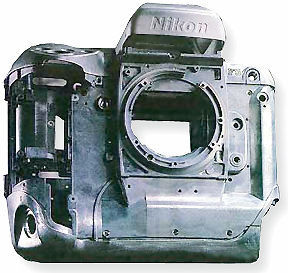 |
When this site was at its preview stage, a surfer left a remark on the message board, disagreeing what I quoted "Nikon is Big, if not cumbersome..". in some ways, he may be right, as the 4-motors design in the F5 + one hell of a complicated electronic circuitry and other mechanical parts which has to screeze inside the rigid protective walls of the camera is no way an easy task for designers .. but I think he may have misunderstood what I intend to convey, as the state of its dimension I was referring was more confined to its overall dimension in its one-piece integrated unit rather than just the camera body itself. As some of you may have also noticed one of the best improvement made to the F5 from its predecessor was actually at the cumbersome hand grip of the F4, the F5 never feels difficult to hold securely in an average-sized palm now (just less than 1/2 inch makes a world of difference in handling) but it has taken a F-generation for Nikon to rectify this area. |
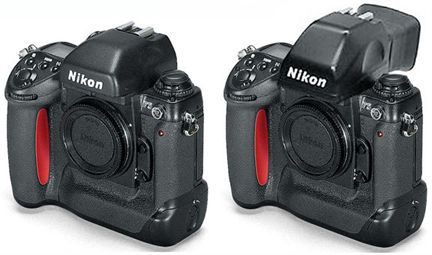 |
Now the unpopular decision to integrate the power pack is generally referred as another weak point in the F5. The F6 has reverted back to the old design again EXCEPT for another debatable move in removing the interchangeable prism feature... will the next F7 comes back with a removable finder again ? who knows. But seemingly, the success story of Canon EOS-1 series has inspired Nikon to think since the Canon pros can live without one, why should they wasting resources to fabricate so many individual components on viewfinder assembly to the F6 ? |
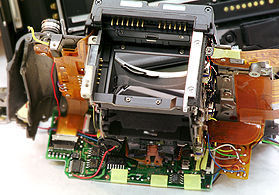 |
Next, hasn't anyone of you noticed that modern photography has put way too much emphasis on technology lately ? Technically, modern cameras require sound knowledge in operating a digital device in order to optimize its full features. Perhaps, it has indirectly created a new term of techno-photography because 2/3 of an image making process is via technologies. It handles focusing, exposures, metering and even flash-in perfect exposed images for you ! The thing left for the guy who holds the camera is how to compose a shot and what attracts him to shoot... but to a pro who might have dead lines to meet or must have "something" to deliver to a fuzzy client, who cares ? |
Well, that sounds terrible.. I know. I don't deny the advantage technology used in a camera, autofocus, which along advanced metering systems for flash and ambient exposure, aided by secondary features like auto-bracketing, built-in custom settings etc.. each of these wonderful features offer a working solution to solve difficult photographic situations. For an instance, just take autofocusing as a point for discussion, one of my friends who happens to be the photo editor of a popular news network sighed and told me once. That throughout his working life as a journalist, autofocusing can easily be the BEST thing ever happened to him. Simply put it has improved his success rate where previously it would have required a little bit of luck than skill to achieve a usable picture for his news publishing.
I could not agree with him more. In fact, it has come to a point that it is almost impossible for anyone to get a badly exposed image anymore. When you relate the simple equation of SHUTTER SPEED + APERTURE = EXPOSURE, you can also notice these were the main areas where all camera manufacturers have centered their development effort on to improve every segment of it during the last 20 years (But strangely, somehow there are less unforgettable images surfaced like the old days where I thought all these lovely technological advances could have made photography more inspiring..and easier to create them). Sad state, indeed.
 |
DON'T pick on me, it is just a rough round up graph for discussion, could missed some important elements. |
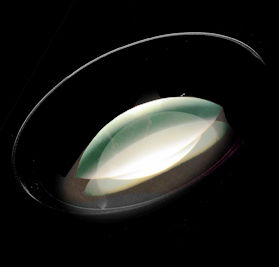 |
Any more room for improvements ? yes. Definitely - but manufacturers also begin to feel the strain in exploring a MAJOR breakthrough in most of these segments as evidenced by the recent (2005) Nikon F6. Which to me, looks more like an upgrade rather than considering it to be an entirely new professional class Nikon. On the other hand, the system road map for digital imaging has PLENTY of room for improvement. This includes starting from the basic format size, resolution (pixels), software conversion, colour management, even including related issues on digital ready Nikkor lenses. Naturally, this is NOT a proprietary problem for Nikon, these issues apply to all the market players. |
Comparing a poor old fashioned photographer in the 80's, all these nice technological advancements in a typical modern day SLR camera are something like a gift from God and to some of us with different age group (a better term for "old"), photography may never be the same again, where during the old days, you tend to command more rather than living on dependency of technology. Another funny phenomenon arising among the techo-photographers is, minor differences in features could end up in a separation of opinions and thinking that label A is better than B or vice versa. Just remember,ALL those advancements in metering systems and exposure control have evolved from the basic equation illustrated above and very few people realize the plain truth that such level in improvement made could only be confined to minor difference within an exposure of 1/3 stop ! To the open minded, it is something of which can be easily resolved by the modern day wide latitude of various film types or by a simple click of a mouse to manipulate during desktop publishing or even using the auto-bracketing to buy insurance for the exposures. Currently, the most advance autofocusing tracking rate currently employed among top performing SLRs has a differential rate of 2 fps (frames per second) on focus tracking. Between the F5 's 8 fps and the F4 (or F90X) so-so performance of 3.4~4.3 fps of 1988/92, burst rate has improved considerably in nearly a fold in performance. For action-based, news reporting or wild life photography, admittedly, it makes tremendous amount of difference in the success rate.
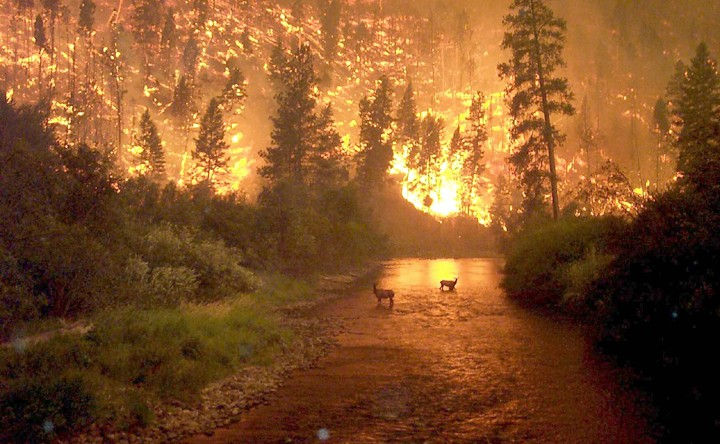 |
You may not require technology to assist you to take GREAT picture like this..Neither any camera you used is important, Your personal interpretation of what you saw is what matters. |
In fact, development in film transport is reaching a plateau in practical usage where most people are starting to think is this enough or is there any necessity in squeezing another few frames more within a second ? Some may say YES, but the majority will say ENOUGH. Those who answer YES may be are the ones that depend very much on technology to bring them a little luck with the extra frames a camera delivers. Which also indirectly signals, dependency again rules in some segments of modern day photography. Camera manufacturers are also hitching a ride on this human weakness by toying around with possibility of a camera that will do all - except for the anticipation, composition and the eye for spotting something interesting to trip the shutter release button. However, in terms of pure film transport (without AF-tracking), they have only improved the film advance rate by 2 fps for the last 20 years (Nikon F3 peak rate is 6 fps) but the main difference is, now, you don't have to manually anticipate the flow of action, the camera will track and focus for you.
As you can notice, this site seldom uses other systems to mark F5 performance. Seriously, I don't like comparing brands. Each label has its strength and weaknesses. Those players who find it hard to establish a footing in this particular highly competitive pro-market will present its own approach on how to carry on with its growth. Olympus or Pentax may think instead of risking resources to build another complete SLR AF-system to try competing with the established, both have diverted to make excellent, respectfully hot selling film & digital P&S cameras. Between the giants, differences can be quite minute where one can excel in some areas over the others. The rest can be just personal interpretation in what system is good for you. So as long as you have committed to a particular label, just live with what you have invested and utilized what your hard-earned cash has turned into. Those who have already built up a reasonably good system should not waste resources by simply thinking another label could do wonders for your photography.
|
|
For an instance, if you think a high performance camera such as fabulous Canon EOS-1v extra 2 fps in AF focusing tracking could mean life & death situation to your profession, why bothers ? just sell all your Nikon gears and switch. Well, at any one time, if you often do high speed bursting of frames in assignments, as all pro-series SLRs may finish a 36-exposures in just 3 sec. while there is no option of 250 exp. Bulk Film Back as alternative anymore, as a modern photographers, you ought to train yourself how to change film roll fast and swift. Essentially, most producers do not emphasize too much on burst rate, adding the fact, it also requires other departments in a camera to improve considerably to deliver maximum level of reliability for extended long professional use. |
|---|
Some people have asked me about a NIKON F5
Serial number & Manufacturers date guide. For all those interested, here are
the details for the NIKON F5:
Serial/Number Manufacture/DATE
3033XXX LATE 1996
30329XX JUN 1997
30372XX MAY 1997
303XXXX SEP 1997
306XXXX LATE 1997
3102XXX LATE 1998
315XXXX DEC 1999
3134XXX AUG 2000
3167XXX AUG 2001
32111XX MAY 2002
321XXXX AUG 2002
3212XXX NOV 2002
3221XXX MAR 2003
__________________________
As a footnote, the oldest Nikon F5 body in my Nikon system (which I still use as
my main tool for expeditions) has a SN of 3119XXX (and still going strong despite
being dropped twice on to rocks from a great hight!). The youngest Nikon F5 body
that I own (with Action Finder DA-30 and Data Back)has a SN of 3230XXX - one of the
very last F5s made during 2004. The F6 came into production in October 2004. -
Info supplied by our friend, GLOBETROTTER <globetrotterworld@hotmail.com>; Website: http://www.myspace.com/globetrotterworld
| Previous | NEXT | 2/3 Other personal thought, Site Development Issues + wall papers for download
| Back | Main Index Page - Nikon F5 Professional SLR camera
As a host, I have nothing to offer you guys, except here are some little souvenirs, Wall Paper(s) for FREE-download:-
The Camera - Background, Issues
& Summary
Basic
Features | Focusing | Metering Systems | Exposure Control | Reliability Issues | Nikkor lens Compatibility
Prisms/Finders - Index page
- 2 parts
Film Backs: Index
Page - 1 parts
Focusing Screens - Index
Page - 1 part
Flash System - Index
Page
- 3 parts
System Accessories: | Power Sources | Cases | Remote
Control | Miscellaneous
Macro
Photography
- Related info on Micro-Nikkor lenses
Technical Specification for Nikon F5
Main
Reference Map
/ Nomenclature
Resource Centre:
Instruction Manuals
Nikon
F5 Camera Body
- 18
parts
MF-28
Multi-Function Back
HTML - 8
parts
PC
Links - Photo Secretary
- 2
parts
AF-TTL Speedlights:
SB-28 / SB28DX | SB29(s) info | SB30 | SB50DX | SB80DX | SB600 info | SB800
Variants: F5 50th Anniversary Model | Nikon/Kodak DCS-620 | DCS-720 Digital Still SLR camera | NASA-modified Nikon F5
| Back | Index Page of Digital
Nikon SLR cameras
|
Back | Main Index Page of Pictorial
History of Nikon SLR cameras
| Nikon F | Nikon F2 | Nikon F3 | Nikon F4 | Nikon F5 | Nikon F6 | Nikkormat / Nikomat | Nikon FM | Nikon FE/ FA | Nikon EM/FG/FG20 | Nikon Digital SLRs | Nikon - Other models |
The Eyes of Nikon:-
Nikon Auto Focus Nikkor lenses:- Main
Index Page
Nikon Manual Focus Nikkor lenses:- Fisheye-Nikkor Lenses - Circular | Full Frame |
Ultrawides Lenses - 13mm15mm18mm20mm | Wideangle Lenses - 24mm28mm35mm | Standard Lenses - 45mm 50mm 58mm | Telephoto
Lenses - 85mm105mm135mm180mm & 200mm | Super-Telephoto Lenses - 300mm 400mm 500mm 600mm 800mm 1200mm |
 Index Page |
Special
Application lenses: Micro-Nikkor Lenses - 50mm~55mm -60mm 85mm -105mm 200mm Micro-Zoom 70-180mm Perspective Control (PC) - 28mm 35mm PC-Micro 85mm Dedicated Lenses for Nikon F3AF: AF 80mm f/2.8 | AF 200mm f/3.5 EDIF Depth of Field Control (DC): 105mm 135mm Medical Nikkor: 120mm 200mm Reflex-Nikkor Lenses - 500mm 1000mm 2000mm Others: Noct Nikkor | OP-Nikkor | UV Nikkor 55mm 105mm | Focusing Units | Bellows-Nikkor 105mm 135mm Nikon Series E Lenses: 28mm35mm50mm100mm135mm | E-Series Zoom lenses: 36~72mm75~150mm70~210mm |
MF Zoom-Nikkor Lenses: 25~50mm | 28~45mm | 28~50mm | 28~85mm | 35~70mm | 36~72mm E | 35~85mm | 35~105mm | 35~135mm | 35~200mm | 43~86mm | 50~135mm | 50~300mm | 70~210mm E | 75~150mm E | 80~200mm | 85~250mm | 100~300mm | 180~600mm | 200~400mm | 200~600mm | 360~1200mm | 1200~1700mm
Tele-Converters: TC-1 | TC-2 | TC-200 | TC-201 | TC-300 | TC-301 | TC-14 | TC-14A | TC-14B | TC-14C | TC-14E | TC-16 | TC-16A | TC-20E
Recommended links to understand more technical details
related to the Nikkor F-mount and production Serial Number:
http://rick_oleson.tripod.com/index-153.html by: my
friend, Rick Oleson
http://www.zi.ku.dk/personal/lhhansen/photo/fmount.htm by: Hansen,
Lars Holst
http://www.mir.com.my/rb/photography/hardwares/nikonfmount/lens2.htm
http://www.photosynthesis.co.nz/nikon/serialno.html
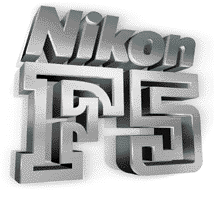 |
| Message Board | for Nikon F5 Series SLR model(s) | |
About this photographic site.
HOME - Photography in Malaysia |
![]()
A resource dedicated to my kids:- Alvin Foo & Esther Foo- one day,
BOTH might need to use all these information for his/her Nikon F5A camera.
Volunteered Maintainer(s) for the Nikon F5 Message Board: Tony Davies-Patrick, UK; Rick Oleson, US; Koh Kho King, Malaysia.
Credit: Mr. Chuck Hester, US for his text re-editing skill for this site; Our staff, HowKiat® who created the 3D-Nikon F5 logo. Mr. Lew Chee Wai of YL camera for lending his F5 for me to take some shots appeared in this site. All those nice folks who have contributed their images, in particular Mr. Mike Long, Edwin leong, Palmi Einarsson, Sergio Pessolano, Fred Kamphues, Harry Eggens, Curtis Forrester, Nick (Natures Moments), Sandra Bartocha; fellow countrymen, Vincent Thian, Koh Kho King, Philip Chong, CY Leow etc. and contributions from a few nice folks from Photo Malaysia Forum. Disclaimers & acknowledgments: Certain content and images appeared in this site were either scanned from official marketing leaflets, brochures published by Nikon and/or contribution from surfers who claimed originality of their own work for public publishing in this website, where majority of the extracted information are used basing on educational merits. The creator of this site will not be responsible for any discrepancies that may arise from any possible dispute except rectifying them after verification from respective source. Neither Nikon or its associates has granted any permission(s) in using their public information nor has any interest in the creation of this site. "Nikon", "Nikkormat", "Nippon Kokagu KK" "Silent Wave", "Focus Tracking Lock-on", "Nikkor" & other applicable technical/business terms are registered trade name(s) of Nikon Corporation Inc., Japan. Site made with an Apple G5 IMac.
